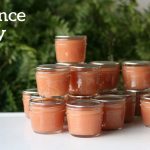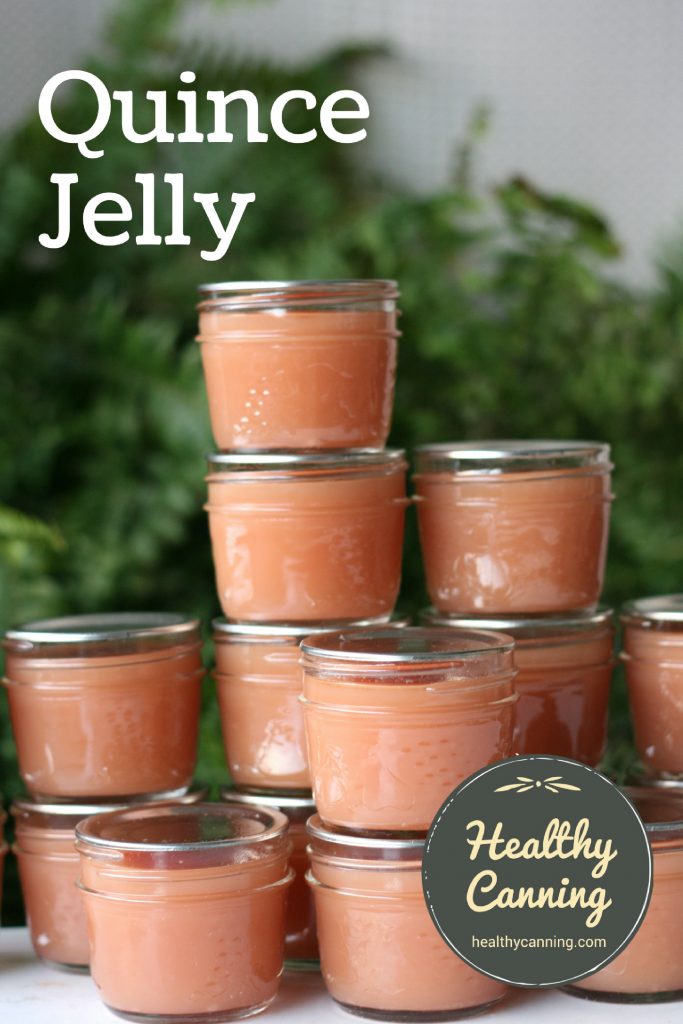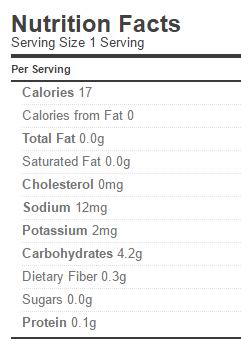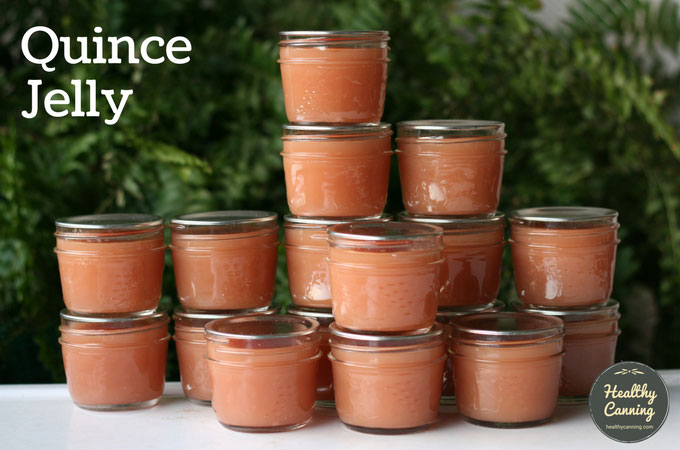This quince jelly has a wonderful, old-world aroma.
You can make this with refined white sugar, with honey, or sugar-free.
This recipe uses Pomona Pectin.
Note: Quince can be gritty like pear, even when strained to make a jelly from.
The recipe
Jar size choices: Either 125 ml (½ cup / 4 oz) OR quarter-litre (½ US pint / 250 ml / 8 oz)
Processing method: Water bath or steam canning
Yield: 4 x quarter-litre (½ US pint) jars
Headspace: 1 cm (¼ inch)
Processing time: Either size jar 10 minutes. Adjust time for altitude when over 300 metres / 1000 feet.

Quince Jelly
Ingredients
- 2 kg quince (4 lbs)
- 500 ml water (2 cups / 16 oz)
- 4 tablespoons lemon juice (bottled)
- 4 teaspoons calcium water
- 4 teaspoons Pomona pectin
- 450 g sugar (white. 2 cups / 16 oz) OR 250 ml honey (1 cup / 8 oz) OR 4 to 5 teaspoons liquid stevia
Instructions
- Wash the quince, cut in half (you can leave skin on and seeds in.)
- Whichever following form of cooking you choose to cook them with, add 500 ml (2 cups) of water before starting cooking.
- Either simmer for 40 minutes, OR pressure cook on high (13 to 15 lbs) for about 5 minutes.
- Mash the fruit, and put in jelly bag or a few layers of cheese cloth to drain for a few hours or overnight.
- You want to end up with 1 litre (4 cups / 32 oz) of juice.
- Put juice in a pot.
- Add the lemon juice and the calcium water.
- Mix the pectin powder with the sugar or the honey (see special directions below for liquid stevia), set aside.
- Bring pot contents to a boil, then add pectin and sweetener mixture.
- When pot returns to a boil, let boil for a minute.
- Ladle hot liquid into hot jars.
- Leave 1 cm (¼ inch) headspace.
- Debubble, adjust headspace.
- Wipe jar rims.
- Put lids on.
- Process in a water bath or steam canner.
- Process jars for 10 minutes; increase time as needed for your altitude.
Nutrition
Liquid stevia directions
- Start the night before or a few hours in advance
- Bring 500 ml (2 cups / 16 oz) of the juice to a boil, either in a pot or in a microwave. (Mind the surge when removing from microwave.)
- Put that heated juice into a jar, add the pectin powder, put lid on and shake well minding the hot sides of the jar.
- Shake a few more times while it is cooling.
- When cool, use right away or if desired, keep cover on and put in fridge overnight, or for a few hours, or for up to two days.
- To make the jelly: lightly spoon off any foam on the surface. Put the jar mixture in a pot along with the rest of the juice, bring to a boil, add the lemon juice, calcium water, and liquid stevia to taste.
- Bring back to a boil, follow canning directions above.
Reference information
Information about Pomona pectin.
How to water bath process.
How to steam can.
When water-bath canning or steam canning, you must adjust the processing time for your altitude.
For stevia, Better Stevia liquid stevia was the stevia used.
More information about Sugar and Salt-Free Canning in general.
Recipe notes
- Because this is made with Pomona Pectin, you can double or triple the batch as desired will no ill-effect on the set of the jelly;
- Pomona pectin comes with a small pouch of powdered calcium for you to mix with water to make calcium water;
- The pectin powder will clump if you just mix it straight into the jelly mixture; that’s why you mix it with something first;
- If you are using sugar, you can reduce the amount of sugar you use and it will not affect the set;
- What makes this recipe safe for canning is the added acidity of the bottled lemon juice (bottled is called for for its assured acidity);
- The juice that came from the quince we used happened to have a pH of 2.3. However, there are many different varieties of quince and growing conditions, so for assured acidity, as well as flavour enhancement, add the lemon juice;
- After opening, refrigerate and use within 3 weeks.
Recipe source
Sumberg, Mary Lou. Developing or Converting Recipes for Cooked Jam or Jelly Using Pomona’s Pectin. Blog post 1 January 2013. Accessed December 2016.
Nutrition
Because the type and amount of sweetener you may add may vary wildly depending on how sour your quinces are, we’re giving nutrition here just for the liquid stevia version, as that doesn’t impact the base nutritional elements of the quince juice, lemon juice, and pectin.
Sugar-free
Per 2 tablespoons
- 17 calories, 12 mg sodium




Amber
Can Bernardin no sugar needed be subbed for Pomona’s? To get that, I have to have a minimum $80 order of the stuff or pay ridiculous shipping, and that’s not very thrifty.
Healthy Canning
This particular recipe relies on Pomona. We’ll be adding more Bernardin and Ball no-sugar pectin recipes in the not so distant future.
Margaret Kenaga
I really appreciate your explanations of why you are using or doing certain things. Thank you.
Healthy Canning
Many people dislike canning directions because they don’t understand why some things are recommended and others not recommended. We hope that by giving the why’s and wherefore’s that it will inform people, and earn people’s buy-in to safe, quality, modern home-canning methods.
Carolyn Svatonsky
Is the Pomona’s Universal Pectin the same as Gel Jel? If quince is so high in pectin why do you use the Pomona’s Universal Pectin or any pectin at all?
Healthy Canning
Not familiar with Gel Jel product; Google brings up nothing sadly.
There’s two ways to set a jam / jelly. By adding a LOT of sugar to interact with the pectin naturally in a fruit and then boiling for a long time. OR by adding additional pectin which allows a much shorter boiling time, and depending on the pectin type, may allow less or no sugar.
I wanted to make a low or no sugar version of quince jelly because I try to emphasize healthier versions of recipes (finding HIGH sugar recipes are never a problem lol.) I used Pomona because I only use recipes from reputable sources, and they had a low or no sugar recipe for quince jelly; Ball and Bernardin did not.
If sugar quantities are not a concern, then yes you can make it with no pectin by adding lots of sugar. Here’s some recipes. There’s Quince Jelly in So Easy to Preserve (2014) page 215, Quince Preserves in So Easy to Preserve (2014) page 225, Quince Preserves in Ball / Bernardin Complete (2015) page 69, Quince Preserves in Ball Blue Book 37th page 66. The National Center for Home Food Preservation has a quince jelly recipe on line here: for 2 cups of jelly, they call for 3 cups of sugar. The recipe is here: https://nchfp.uga.edu/how/can_07/quince_jelly.html That’s what I was able to find for you in a quick 5 minute browse of reputable home canning recipe sources. Hope that helps!